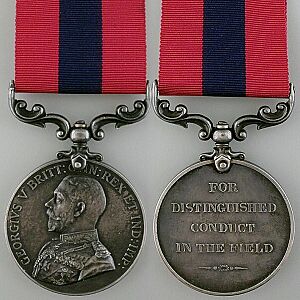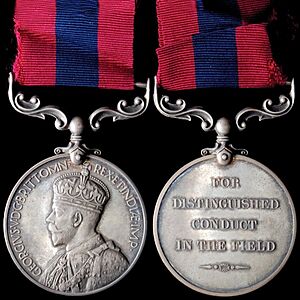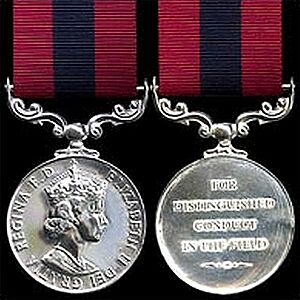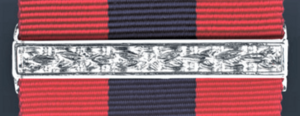Distinguished Conduct Medal facts for kids
Quick facts for kids Distinguished Conduct Medal |
|
|---|---|
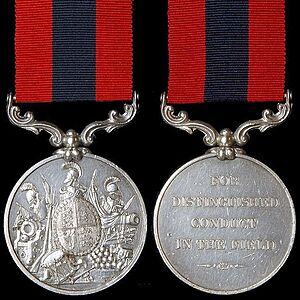
Queen Victoria version
|
|
| Presented by | the Monarch of the United Kingdom of Great Britain and Ireland |
| Country | |
The Distinguished Conduct Medal (often called the DCM) was a special award for bravery. Queen Victoria created it in 1854. It was given to soldiers who showed great courage in battle.
The DCM was for "other ranks." This means it was for soldiers who were not officers. It was the second highest award for bravery, just below the famous Victoria Cross. The medal was stopped in 1993. It was replaced by the Conspicuous Gallantry Cross. Soldiers from other Commonwealth countries could also receive this medal.
Contents
What is the Distinguished Conduct Medal?
The Distinguished Conduct Medal was officially started on December 4, 1854. This was during the Crimean War. It was given to warrant officers, non-commissioned officers, and regular soldiers. They received it for "distinguished, gallant and good conduct in the field."
Before the DCM, there wasn't an official medal just for bravery. The Meritorious Service Medal was sometimes given for bravery. But its main purpose was to reward long service.
Soldiers who received the DCM also got some money. This money was given when they left the Army. From 1918, recipients could use the letters DCM after their name. This showed they had earned the medal.
What are "Bars" on a Medal?
Sometimes, a soldier would do another brave act. If they had already received the DCM, they could get a "bar." A bar is a small silver clasp added to the medal's ribbon. Each bar meant another act of bravery. This system started in 1881.
During the First World War, many DCMs were given out. People worried the medal might lose its special meaning. So, in 1916, the Military Medal was created. This new medal was for bravery too, but the DCM was kept for even more amazing acts. About 25,000 DCMs were awarded in the First World War. Around 1,900 were given during the Second World War.
Who Could Receive the DCM?
At first, the DCM was mainly for soldiers in the British Army. But over time, more people became eligible.
In 1872, soldiers from British colonies could also receive it. The first awards to colonial troops went to the West India Regiment. However, soldiers from the Indian Army usually received their own awards. These included the Indian Order of Merit.
Later, in 1916, members of the Royal Naval Division could also get the DCM. By 1942, it was no longer just for the Army. Sailors from the Royal Navy and airmen from the Royal Air Force could also earn it. This was if they showed bravery in ground combat.
In 1979, a new rule was made. The DCM could be awarded even if a soldier had died. Before this, only the Victoria Cross could be given after someone had passed away.
How Was the DCM Adopted by Other Countries?
Some British colonies and countries adopted the DCM. This meant they could award it to their own local forces. For example, Natal and Cape Colony in South Africa adopted it in 1894. Australia, Canada, and New Zealand also adopted it. However, only the Natal and Canadian versions were actually awarded.
Special African Distinguished Conduct Medals were created in 1903. These were for soldiers in the King's African Rifles and the Royal West African Frontier Force. But these were later replaced by the main British DCM in 1943.
These colonial DCMs looked like the British one. But they had an extra inscription on the back. This showed which territory or unit the soldier belonged to.
Why Was the DCM Stopped?
The Distinguished Conduct Medal was stopped in 1993. This was part of a big review of British awards. The goal was to have fewer different medals for bravery. They wanted to remove differences based on rank.
The DCM, along with the Conspicuous Gallantry Medal, was replaced. They were all replaced by the Conspicuous Gallantry Cross. This new medal became the second highest award for bravery. It could be given to all ranks in all parts of the armed forces.
After the Second World War, many Commonwealth countries created their own awards. They no longer used British medals. The last DCMs for the Canadian Army were for the Korean War. The last Australian DCM was awarded in 1972 for the Vietnam War. New Zealand's last award was in 1970. These countries now have their own bravery awards.
Where Does the DCM Rank?
In the official order of British medals, the DCM is very important. It ranks just after the Air Force Cross. It ranks before the Conspicuous Gallantry Medal.
What Did the Medal Look Like?
The DCM was a silver medal. It was about 36 millimeters wide and 3 millimeters thick. The medal had a fancy hanger at the top. This hanger connected the medal to its ribbon. On early medals, the medal could even swivel.
Every medal had the recipient's number, rank, name, and unit written on its edge.
- The Front (Obverse)
The front of the medal changed over time. There were eight different versions.
- The first version, from Queen Victoria's time, showed a "Trophy of Arms." This was a design with weapons and a shield.
- After 1902, the picture of the reigning monarch was on the front. Their name and titles were written around the edge.
- For King Edward VII, it said "EDWARDVS VII REX IMPERATOR."
- For King George V, there were two versions. One showed him bareheaded, the other crowned.
- For King George VI, there were also two versions.
- For Queen Elizabeth II, there were two versions as well.
- The Back (Reverse)
The back of all DCM medals was smooth. It had a raised edge. The words "FOR DISTINGUISHED CONDUCT IN THE FIELD" were written in four lines. A laurel wreath design was below the words.
- The Bars
The bars for second or later awards were straight and made of silver. Bars given between 1881 and mid-1916 had the month and year of the award. Later bars, after mid-1916, had a laurel-spray design instead of a date. If a soldier wore only the ribbon, a small silver rosette was added. Each rosette showed that a bar had been awarded.
- The Ribbon
The ribbon for the DCM was 32 millimeters wide. It was dark crimson (a deep red color). It had a 10-millimeter wide navy blue stripe in the middle.
Who Received the DCM?
All awards of the Distinguished Conduct Medal were announced. This happened in The London Gazette. During the First World War, the reasons for the award were often included.
From 1854 to 1914, 3,529 medals were given. There were also 13 second award bars. About 808 medals were for the Crimean War. Another 2,092 were for the Second Boer War. Six medals were given after death during the Boer War.
For the First World War, 24,620 medals were awarded. There were also 472 first bars and nine second bars. Another 46 awards were made between 1920 and 1939.
For the Second World War, 1,891 medals and nine first bars were given.
After the wars, 153 DCMs were earned between 1947 and 1979. This included 45 to Australian and New Zealand forces for service in Vietnam. Another 25 awards were made after 1979. These included nine for service in Northern Ireland. Eight were for the South Atlantic and eight for the Gulf War.
The DCM was also given as an "honorary award" to soldiers from allied countries. This means they were not British. For example, 5,227 were given during the First World War. Another 107 were given during the Second World War.
Australian Recipients
The Distinguished Conduct Medal was awarded to 2,071 members of the Australian Army. Three members of the Royal Australian Air Force also received it. Thirty first bars were awarded to Australians. Most of these were for actions during the First World War. The last award to an Australian was in 1972. This was for service in the Vietnam War.
Canadian Recipients
The first Canadian received the medal on April 19, 1901. In total, 2,132 awards went to Canadian Army and Royal Canadian Air Force personnel. There were also 38 first bars and one second bar.
New Zealand Recipients
Between 1899 and 1970, 525 Distinguished Conduct Medals were given to New Zealanders.
South African Recipients
More than 300 Distinguished Conduct Medals were awarded to South Africans. These were given during the First and Second World Wars.
See also
- Distinguished Conduct Medal (Natal)
- West African Frontier Force & King's African Rifles Distinguished Conduct Medal
- Orders and decorations of the Commonwealth realms
- Recipients of the Distinguished Conduct Medal



